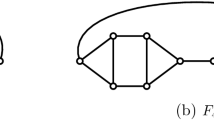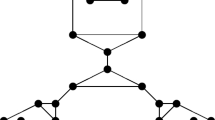Abstract
A set S of vertices in a graph G is a dominating set if every vertex not in S is adjacent to a vertex in S. If, in addition, S is an independent set, then S is an independent dominating set. The independent domination number i(G) of G is the minimum cardinality of an independent dominating set in G. In Goddard and Henning (Discrete Math 313:839–854, 2013) conjectured that if G is a connected cubic graph of order n, then \(i(G) \le \frac{3}{8}n\), except if G is the complete bipartite graph \(K_{3,3}\) or the 5-prism \(C_5 \, \Box \, K_2\). Further they construct two infinite families of connected cubic graphs with independent domination three-eighths their order. In this paper, we provide a new family of connected cubic graphs G of order n such that \(i(G) = \frac{3}{8}n\). We also show that if G is a subcubic graph of order n with no isolated vertex, then \(i(G) \le \frac{1}{2}n\), and we characterize the graphs achieving equality in this bound.








Similar content being viewed by others
References
Abrishami G, Henning MA (2018) Independent domination in subcubic graphs of girth at least six. Discrete Math. 341:155–164
Brause C, Henning MA (2019) Independent domination in bipartite cubic graphs. Graphs Combin. 35(4):881–919
Dorbec P, Henning MA, Montassier M, Southey J (2015) Independent domination in cubic graphs. J. Graph Theory 80(4):329–349
Favaron O (1992) A bound on the independent domination number of a tree. Vishwa Int. J. Graph Theory 1:19–27
Furuya M, Ozeki K, Sasaki A (2014) On the ratio of the domination number and the independent domination number in graphs. Discrete Appl. Math. 178:157–159
Goddard W, Henning MA (2013) Independent domination in graphs: a survey and recent results. Discrete Math. 313:839–854
Goddard W, Lyle J (2012) Independent dominating sets in triangle-free graphs. J. Comb. Optim. 23(1):9–20
Goddard W, Henning MA, Lyle J, Southey J (2012) On the independent domination number of regular graphs. Ann. Combin. 16:719–732
Haviland J (1995) Independent domination in regular graphs. Discrete Math. 143:275–280
Haviland J (2007) Upper bounds for independent domination in regular graphs. Discrete Math. 307:2643–2646
Henning MA, Yeo A (2013) Total domination in graphs (Springer monographs in mathematics), ISBN: 978-1-4614-6524-9 (Print) 978-1-4614-6525-6 (Online)
Henning MA, Löwenstein C, Rautenbach D (2014) Independent domination in subcubic bipartite graphs of girth at least six. Discrete Appl. Math. 162:399–403
Kostochka AV (1993) The independent domination number of a cubic \(3\)-connected graph can be much larger than its domination number. Graphs Combin. 9(3):235–237
Lam PCB, Shiu WC, Sun L (1999) On independent domination number of regular graphs. Discrete Math. 202:135–144
Lyle J (2014) A note on independent sets in graphs with large minimum degree and small cliques. Electr. J. Comb. 21(2):P2.38
Lyle J (2015) A structural approach for independent domination of regular graphs. Graphs Combin. 31(5):1567–1588
Rad NJ, Volkmann L (2013) A note on the independent domination number in graphs. Discrete Appl. Math. 161:3087–3089
Southey J, Henning MA (2013) Domination versus independent domination in cubic graphs. Discrete Math. 313(11):1212–1220
Suil O, West DB (2016) Cubic graphs with large ratio of independent domination number to domination number. Graphs Combin. 32(2):773–776
Wang S, Wei B (2017) A note on the independent domination number versus the domination number in bipartite graphs. Czechoslovak Math. J. 67(2):533–536
Acknowledgements
The research of the second author was supported by grant number (G981202) from the Sharif University of Technology.
Author information
Authors and Affiliations
Corresponding author
Additional information
Publisher's Note
Springer Nature remains neutral with regard to jurisdictional claims in published maps and institutional affiliations.
Rights and permissions
About this article
Cite this article
Akbari, A., Akbari, S., Doosthosseini, A. et al. Independent domination in subcubic graphs. J Comb Optim 43, 28–41 (2022). https://doi.org/10.1007/s10878-021-00743-z
Accepted:
Published:
Issue Date:
DOI: https://doi.org/10.1007/s10878-021-00743-z




